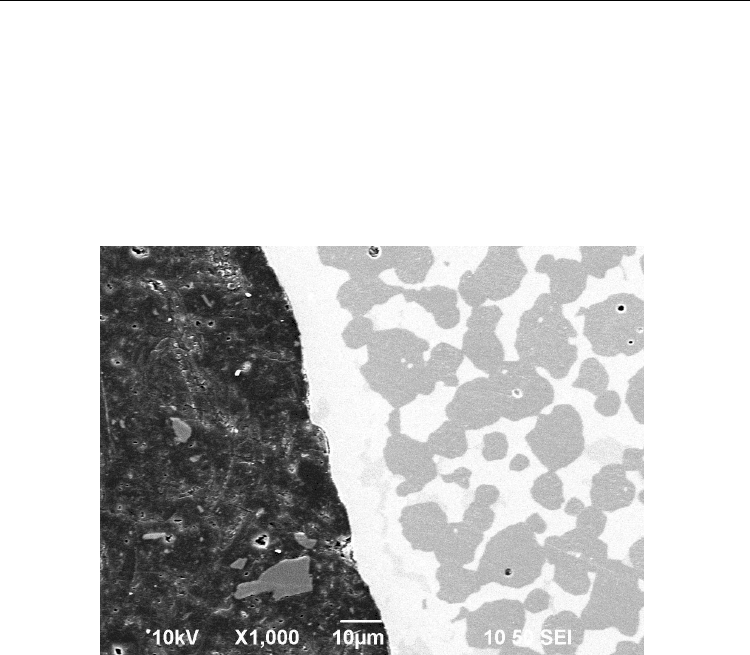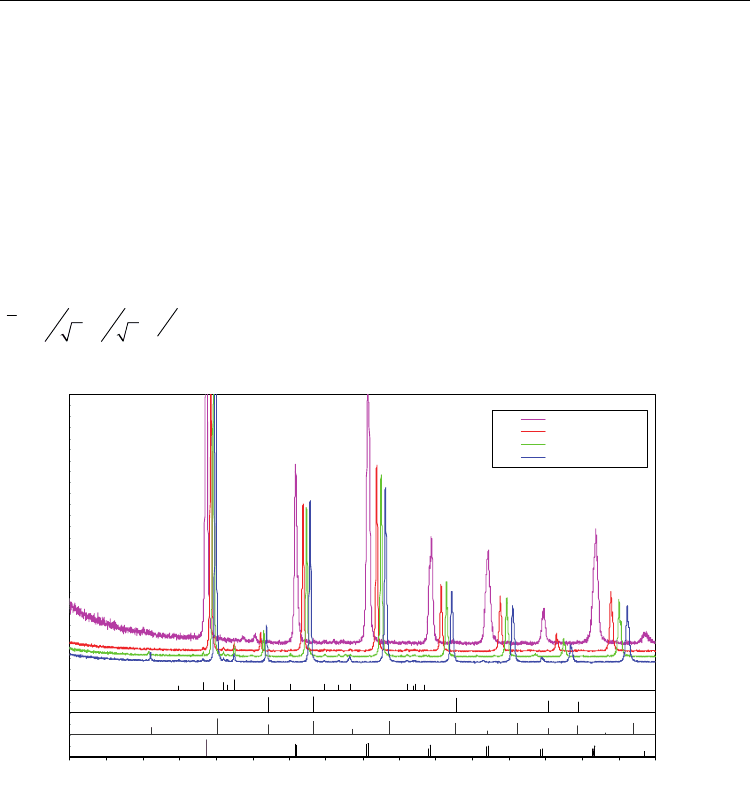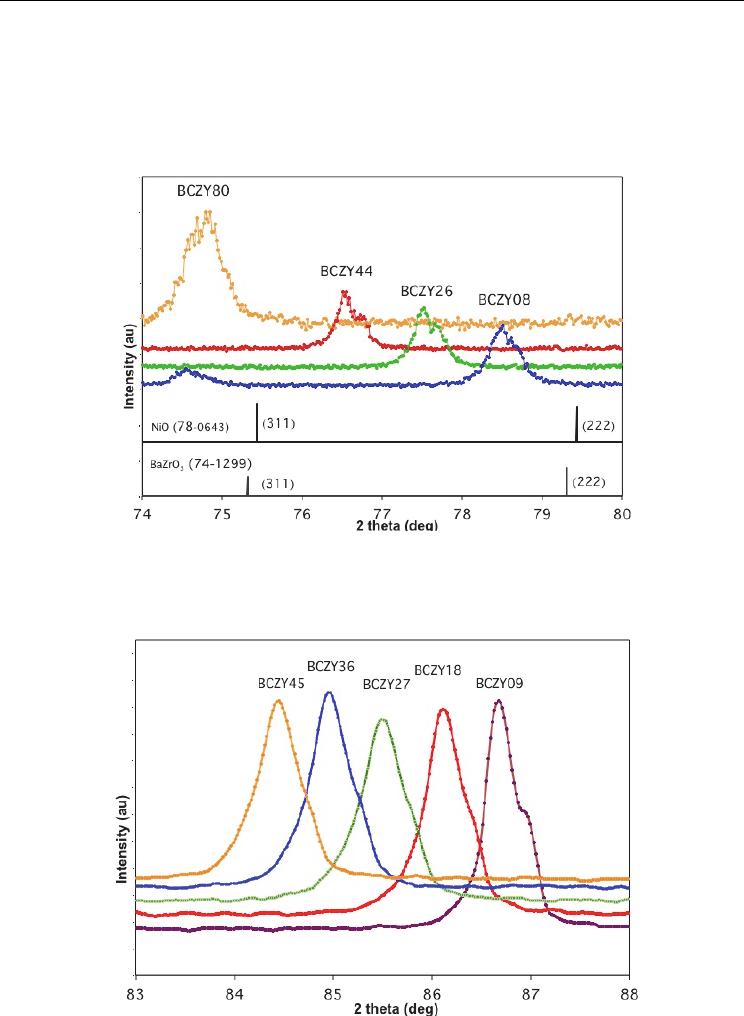Sikalidis C. (ed.) Advances in Ceramics - Synthesis and Characterization, Processing and Specific Applications
Подождите немного. Документ загружается.

21
Co-Ionic Conduction in Protonic Ceramics of
the Solid Solution, BaCe
(x)
Zr
(y-x)
Y
(1-y)
O
3-
Part I: Fabrication and Microstructure
W. Grover Coors
CoorsTek, Inc.
USA
1. Intoduction
Protonic ceramics have unique transport properties that make them suitable for applications
in intermediate temperature fuel cells and steam electrolyzers, hydrogen separation
membranes, and various membrane reactors for chemical synthesis. Since the discovery of
ceramic proton conductors more than twenty years ago, and the ensuing enthusiasm,
practical issues relating to ceramic fabrication have hampered advancement of the
technology. The best ceramic proton conductors were thought to be acceptor-doped barium
cerates, but these turned out not to be chemically stable in the typical use environments. The
other leading candidates, acceptor-doped barium zirconates, proved too difficult to sinter.
Most other protonic ceramics investigated either exhibited much lower conductivity or poor
chemical stability. Two breakthroughs have recently taken place making it feasible, for the
first time, to manufacture these ceramic proton conductors commercially and inexpensively
with the prerequisite properties. First, the recognition that barium cerate and barium
zirconate form a complete solid solution (BaCe
x
Zr
y-x
Y
1-y
O
3-
, for all values of 1 > y > 0.8 and
x between 0 and y), has made it possible to tailor the mechanical, chemical and transport
properties for various applications. Second, the discovery of solid state reactive sintering has
made it possible to prepare dense, phase-pure ceramics at reasonable temperatures. This
chapter describes fabrication and characterization of BCZY proton conductors using 1-2
wt% NiO as a sintering additive for solid state reactive sintering.
2. Background
Certain ABO
3
perovskite ceramic oxides containing acceptor dopants have high
concentrations of extrinsic oxygen ion vacancies that give rise to unique ionic transport
properties. Many ceramic proton conductors in this group have been identified, most
notably where A = Ba or Sr and B = Ce or Zr. Certain aliovalent cations, where Y
+3
is
prototypical, may substitute for B sites otherwise occupied by Ce
+4
or Zr
+4
, in mole fractions
as high as 20-30% before the structure becomes unstable. The resulting charge imbalance in
the crystal lattice is compensated for by the creation of oxygen ion vacancies on the anion
sublattice. These oxygen ion vacancies each carry a net double-positive charge, so that two
dopant ions are required for each oxygen ion vacancy created, in order to maintain

Advances in Ceramics - Synthesis and Characterization, Processing and Specific Applications
480
electroneutrality. Yttrium-doped barium cerate, BaCe
(1-x)
Y
x
O
3-d
(BCY), has long been
recognized as one of the best ceramic proton conductors. Iwahara carried out the first
systematic evaluation of the ionic conduction properties of barium cerate in 1988 (Iwahara,
et al., 1988). It is straightforward to fabricate this ceramic material by traditional solid-state
reaction, and for this reason, it has been one of the most extensively studied of all the
ceramic proton conductors. Nonetheless, concerns have persisted about the chemical
stability in moist carbon dioxide, which corrodes the ceramic to form barium carbonate and
hydroxide. Since many applications for ceramic proton conductors involve operation in hot,
moist CO and CO
2
atmosphere, interest in BCY as a practical material has waned.
Yttrium-doped barium zirconate, BaZr
(1-x)
Y
x
O
3-d
(BZY) has also been recognized as a good
ceramic proton conductor for many years, but without the same concerns about chemical
stability in moist CO
2
as with BCY. Kreuer reported transport properties of BZY for the first
time using single crystals and sintered ceramics (Kreuer, 1999). Schober and Bohn were also
able to prepare dense ceramic specimens (Schober & Bohn, 2000), although as was the case
with Kreuer, a sintering temperature above 1700 ºC for 30 hours was required. Difficulty in
producing dense polycrystalline specimens has hindered the development of this material.
The traditional processing routes of synthesizing fine powders by solid-state reaction or
spray pyrolysis produce powders that are difficult to sinter below 1700 ºC, even when hot-
pressed. The reason that the material is so difficult to sinter is not yet fully understood, but
firing at such high temperatures tends to volatilize barium, leaving the material A-site
deficient, and the resulting ceramic exhibits poor proton conductivity. Magrez and Schober
successfully synthesized dense BZY at 1500 ºC by a polyacrilamide gel method (Magrez &
Schober, 2004), but the method has apparently never been fully optimized. Münch
published a comparative analysis of BCY and BZY by quantum molecular dynamics
simulation (Münch, et al., 2000), which suggested that BZY should be, in principle, a very
good proton conductor. However, high impedance to proton transport across grain
boundaries in polycrystalline specimens is thought to be the main reason that measured
ionic conductivity is much lower than predicted. More recently, many interesting methods
have been proposed for synthesizing polycrystalline BZY. Perhaps one of the most
ingenious involves converting a thin layer of 8 mol% yttria-stabilized zirconia (8YSZ) into
BZY by reacting with BaCO
3
in situ (Schober, 2005). Nonetheless, to our knowledge, the
high grain boundary impedance problem has never been solved using traditional synthesis,
dampening commercial interest in pure BZY as a proton conductor. A comprehensive
review of the progress on these materials prior to 2003 has been provided by Kreuer
(Kreuer, 2003).
A critical breakthrough in producing BZY was first reported by Babilo and Haile, who
found that dense BZY ceramics could be prepared at a sintering temperature of only 1300 ºC
for four hours when transition metal oxides, ZnO, CuO or NiO, were added up to 4 mol%
(Babilo & Haile, 2005). Without the addition, BZY remained substantially porous.
Independently, Tao and Irvine demonstrated the same discovery of ZnO as an effective
sintering additive for preparing BZY (Tao & Irvine, 2006, 2007). The effect has subsequently
been reported by several investigators (Tong, et al., 2010a, 2010b; Wang, et al., 2009; Xu, et
al., 2010). Enhanced sinterability of BZY with 1 wt% NiO has been demonstrated in our lab
(Coors, 2008). The exact mechanism responsible for the dramatic improvement in
sinterability remains controversial, but the result has been widely confirmed. Transition

Co-Ionic Conduction in Protonic Ceramics of the
Solid Solution,BaCe
(x)
Zr
(y-x)
Y
(1-y)
O
3-
Part I: Fabrication and Microstructure
481
metal oxides have also been used as sintering aids with BCY to lower the sintering
temperature and to investigate the effect of these additions on conductivity. Shimura used
Mn, Co and Fe - finding cobalt to be the most effective (Shimura, et al., 2005). Costa reported
that 4 mol% NiO lowered the sintering temperature of BCY by 200 ºC (Costa, et al., 2009).
Tong used 2 mol% NiO to fabricate BCY20 (Tong, et al. 2010c), and we also confirmed this
effect with NiO in our lab (Coors, et al., 2009). In all cases, no significant difference in
conductivity of BCY has been observed, with or without these sintering aids, so it has
generally been concluded that small additions of 2
+
transition metal oxides has negligible
impact on the transport properties and structure, other than to enhance sintering and
increase average grain size. In the case of BZY20, Tong and O’Hayre reported high
conductivities in moist argon (Tong, et al., 2010a, 2010b). A clear path forward to producing
these protonic ceramic materials now seems possible.
In the meantime, a parallel path in the development of ceramic proton conductors was being
pursued. The idea of solid solutions of BCY and BZY was initially proposed by Wienströer
& Wiemhöfer stating that, “A solid proton conductor that combines the higher chemical
stability of the zirconates and the high conductivity of the cerates could solve these
problems” (Wienströer & Wiemhöfer, 1997). Since barium cerate and barium zirconate are
nearly isomorphic, it was expected that they would be end members of a binary solid
solution where B-sites are randomly occupied by either Zr
+4
or Ce
+4
. This idea was
demonstrated for BaCe
0.9-x
Zr
x
Nd
0.1
O
2.95
for 0.1≤x≤0.6 by Ryu (Ryu & Haile, 1999) and
subsequently for BaCe
0.9-x
Zr
x
Gd
0.1
O
2.95
for 0<x<0.4. Katahira (Katahira, et al. 2000), Zhong
(Zhong, 2007), Ricote (Ricote, et al., 2009a, 2009b) and Guo (Guo, et al. 2009) extended the
investigation to yttria dopant in BaCe
0.9-x
Zr
x
Y
0.1
O
2.95
for 0≤x≤0.9. These papers all confirmed
that a stable solid solution existed, and that chemical stability could be improved without
significantly diminishing the protonic conductivity. However, it still proved difficult in
practice to obtain uniform mixing of the BCY and BZY phases, and high sintering
temperatures were still required to prepare dense polycrystalline specimens.
The solution to this problem was, naturally, to extend the use of transition metal oxide
sintering additives, originally used only with the end members, BCY and BZY, to the whole
range of solid solutions. This approach was first reported by Tao (Tao & Irvine, 2007) and
more recently by Wang (Wang, et al., 2009). Azimova reported BCZY using CoO as a
sintering aid (Azimova & McIntosh, 2009). Most recently Ricote reported very satisfactory
results for BaCe
0.2
Zr
0.7
Y
0.1
O
2.95
prepared by solid state reactive sintering using 1-2 wt% NiO
(Ricote, et al., 2011). The development of protonic ceramics based on BCY-BZY solid
solutions with transition metal oxide sintering aids has provided new latitude in the design
of functional proton conductors and has now become a significant factor in the development
of practical protonic ceramics.
2.1 Nomenclature
A note on nomenclature is in order. The number of compositional variants of these materials
is enormous. In order to avoid writing out the entire formula each time, abbreviations are
typically used, but almost every investigator has a unique system, and there has been no
consistency in the literature. Also, BaCe
x
Zr
0.9-x
Y
0.1
O
2.95
often appears as BaCe
0.9-x
Zr
x
Y
0.1
O
2.95
–
the only difference being which B-site cation the variable applies to. Ricote and colleagues at
Risø in Denmark recently proposed a simple notation that solves these problems, and will
be used throughout the following text (Ricote, et al., 2009). The basic formula is BCZMnm,

Advances in Ceramics - Synthesis and Characterization, Processing and Specific Applications
482
for barium, cerium, zirconium and M-dopant (Y, Gd, Nd, etc.). The cerium and zirconium
mole fractions are n and m times ten. The nominal B-site occupancy is x
M
+x
n
+x
m
=1. The
critical ratio n/m can be correlated to chemical stability. The dopant mole fraction x
M
is
implied as (1-x
m
-x
n
). For example, BaCe
0.5
Zr
0.4
Y
0.1
O
3-d
becomes BCZY54, and BCZY44 refers
to BaCe
0.4
Zr
0.4
Y
0.2
O
2.95
. The end members of the solid solution, which were previously often
designated as BCY20 and BZY20, now become BCZY80 and BCZY08, respectively, in the
new nomenclature. A complication with this notation arises when sintering aids or
secondary dopants are used. The Risø notation cannot easily accommodate multiple B-site
dopants. Nonetheless, without some type of simplifying notation, the formulas become
needlessly complex and difficult to compare. In what follows, only the major dopant will be
included in the formula with the sintering additive given as a prefix, for example,
2NiBCZY26 is just BaCe
0.2
Zr
0.6
Y
0.2
O
2.95
plus 2 wt% NiO.
For hydrogen/air protonic ceramic fuel cells PCFCs and steam electrolysis cells PCECs
(Irvine, et al. 2007), where humid air is used, chemical stability against CO
2
below about 1%
may be sufficient. But the most interesting applications for protonic ceramics that are now
being considered will require stability against much higher concentrations. For example, the
anode gas of a PCFC operating on methane or other hydrocarbon fuels at high fuel
utilization will approach 100% CO
2
. Various electrolytic cells for producing syngas,
including membrane reactors, may also be expected to have high CO and CO
2
concentrations in contact with the ceramic at moderate temperatures ranging from 500 to
800 ºC. The end member, barium cerate (BCZY90), is unstable in CO
2
, but several
investigations have been carried out to determine the maximum value of the ratio of Ce/Zr
(n/m) for which the ceramic is chemically stable. Tao reported ZnO-BCZY53 to be stable in
pure CO
2
in this range of temperatures (Tao & Irvine, 2006). Ryu reported that the more
ceria-rich, ZnO-BCZY72 is also stable in CO
2
for the ratio of n/m ≤ 7/2 (Ryu & Haile, 1999).
However, Zhong observed a small amount of BaCO
3
formation at BCZY72, but not in
BCZY54 (Zhong, 2007). Ricote similarly found BCZY63 to be unstable, while BCZY27 was
completely stable in pure CO
2
(Ricote, et al., 2009).
3. Reactive sintering
It is a good idea from the outset to carefully lay down definitions for the term, reactive
sintering, and the other related terms that have to do with how polycrystalline ceramic
materials are actually fabricated from powders. The idea of reactive sintering is nothing
new. Kingery described it in his definitive textbook on ceramics, “During the firing
process…in many ceramics there may be solid-state reactions forming new phases,
polymorphic transformations, [and] decompositions of crystalline compounds to form new
phases …” (Kingery 1960, p.448). Reactive sintering is an important industrial process, but it
is often overlooked during the research and development phase because of the convenience
of procuring high purity pre-calcined ceramic powders.
Solid-state reaction: Solid state-reaction is a general term that pertains (in the context of
making ceramics) to producing new solid product phases from other reactant phases below
the melting point of either products or reactants. At a given temperature, the phase with the
lowest Gibbs free energy will prevail, but because ion mobility in solids is often very low,
even near the melting point, equilibrium may not be achieved in reasonable time scales.
Solid-state reactions require intermixing of ions from reactant phases by solid state
diffusion, therefore, solid-state reactions are enhanced by making the diffusion lengths as

Co-Ionic Conduction in Protonic Ceramics of the
Solid Solution,BaCe
(x)
Zr
(y-x)
Y
(1-y)
O
3-
Part I: Fabrication and Microstructure
483
short as possible. This is commonly accomplished by starting with very fine, well-mixed
reactant crystallites that can be obtained by attrition milling, sol-gel methods or pyrolysis of
salts precipitated from solution. Almost all specialty ceramic powders are prepared by one
of these techniques. One common method for making fine, single phase BCZY powder is by
solid-state reaction using carbonates and oxides.
1300
32 223 0.80.232
(0.8 ) 0.1 ( )
C
xx
BaCO xCeO x ZrO Y O BaCe Zr Y O CO g
(1)
Traditional sintering: The traditional approach to fabricating ceramic perovskites is to begin
by preparing phase pure powders of the correct stoichiometry by solid-state reaction (such
as Eq.1), milling the resulting powder, called calcine, and then compacting the powder into
green bodies for subsequent ceramic sintering at high temperatures.
Solid-State Reactive Sintering: For solid-state reactive sintering, SSRS, the discrete steps of
solid-state reaction and traditional powder sintering are combined into a single processing
step. The precursor powders are mixed with binders and compacted into a green body. This
is only possible when the kinetics of solid state reaction are fast enough so that reaction-
product crystallites form prior to, or simultaneously with, sintering. This fabrication method
has been described by Babilo and Haile, where certain transition metal oxides, such as NiO,
ZnO, and CuO, were included in the formulation (Babilo & Haile, 2005), and Tao with ZnO
(Tao & Irvine, 2006). The transition metal oxides promote the formation of the equilibrium
phase while simultaneously enhancing densification by sintering.
Sintering additives: The metal oxide is more than just a “sintering aid”. A traditional sintering
aid promotes transport at the surface along grain boundaries, assisting densification,
without substantially interacting with the bulk phases. In reactive sintering, the metal oxide
ions are believed to play a crucial role in ion exchange and diffusion within the grains as
well as at grain boundaries. Often a eutectic liquid phase forms between the transition metal
oxide and the alkali metal, dissolving the other oxides, from which the desired perovskite
phase is produced. In this sense, transition metal oxides are used as reactive sintering
additives. The solubility limit of NiO in the host BCZY is about 1 wt%. Any additional NiO
shows up as a distinct second phase. There is some controversy surrounding where the
dissolved nickel ions end up after sintering – whether they go into interstitial sites or
substitute for B- or even A-sites, or remain at grain boundaries as an amorphous second
phase. These questions may have considerable bearing on the electronic properties, but as a
practical matter, it is nearly impossible to draw any concrete conclusions about nickel in the
structure at such low concentrations.
In a recent development, Yamazaki reported that dense BZY ceramics could be prepared at
moderate sintering temperature by SSRS without any sintering additives at all (Yamazaki, et
al., 2009). That is, the solid-state reaction and sintering steps were carried out
simultaneously, but apparently without the need for sintering additives (beyond the trace
impurities in the starting materials). This raises new questions about what role played by
transition metal oxides in the sintering process, possibly opening up a whole new direction
in practical protonic ceramic fabrication. In our lab, we have found that when a slurry of
precursor oxides and carbonates is applied to the surface of a NiO-BCZY composite
substrate, a thin film membrane of dense BCZY electrolyte forms during co-sintering, even
when no NiO is added to the slurry. During sintering, some NiO diffuses from the substrate
into the membrane up to the solubility limit of about 1 mol%, but whether or not this NiO is
actually necessary for densification of the membrane is not known at this time. A polished

Advances in Ceramics - Synthesis and Characterization, Processing and Specific Applications
484
section of a supported membrane produced this way is shown in Figure 1. The light areas
are BCZY26 phase and the grey areas are NiO grains. (The dark region on the left is potting
compound.) A dip coated and co-fired BCZY26 electrolyte membrane, about 15 m thick,
and typical of the membranes required for various practical devices, is shown. It is apparent
from the image that both phases are independently contiguous except through the
membrane region, which shows no evidence of penetration by NiO. It is also apparent in the
image that the sintered specimen is almost fully dense. The residual spherical pores visible
within the NiO grains are typical of liquid phases formed during sintering. No porosity is
visible in the BCZY26 phase or at BCZY26/NiO grain boundaries.
Fig. 1. Polished cross section of as-fired (unreduced) 68NiBCZY26 with 15 m dip-coated
membrane. Light regions are BCZY26 and dark regions are NiO (SEI-1000x).
4. Ceramic fabrication method
Precursor powders, BaCO
3
, CeO
2
, ZrO
2
and Y
2
O
3
were dried and weighed to obtain the
desired nominal stoichiometery for the BaCe
x
Zr
0.8-x
Y
0.2
O
2.9
. An additional 1 wt% NiO was
included as a sintering additive, but was not included in the stoichiometry, as we have
found that NiO resides at grain boundaries, and nickel ions do not remain in the ABO
3
perovskite structure after sintering. Specimens of 1NiBCZY, with 20 mol% Y and Ce-Zr; 80,
44, 26, and 08, and 10 mol% Y with Ce-Zr; 45, 36, 27, 18, 09 were prepared for XRD analysis
by conventional powder processing in a 19mm diameter uniaxial compaction die. Extruded
1NiBCZY26 and 1NiBCZY27 tubes were also fabricated by solid state reactive sintering from
precursor oxides and carbonates. Barium carbonate (Alfa Aesar, tech grade, 99.6%, Item#
43478, BaCO
3
), zirconium oxide (Neo Performance Materials (AMR Ltd), ≥99.5%, Item#
2802004, ZrO
2
), cerium oxide (Neo Performance Materials (AMR Ltd), ≥99.5%, Item# 4-02-
13-01, CeO
2
), yttrium oxide (HJD Intl. 99.99+%, ultra fine, Y
2
O
3
) and nickel oxide (Inco,
Grade F NiO) were used for the synthesis of the ceramic tubes, prepared according to the

Co-Ionic Conduction in Protonic Ceramics of the
Solid Solution,BaCe
(x)
Zr
(y-x)
Y
(1-y)
O
3-
Part I: Fabrication and Microstructure
485
powder formulation given in Table 1 for BCZY26, as an example. The precursor powders
were blended with water soluble acrylic and cellulosic ether plasticizers. The tubes were
extruded on a 40-ton Loomis extruder. The spindle diameter was 7.14 mm and die diameter
was 9.91mm. The extruded tubes were dried for a week in controlled humidity on plaster V-
groove setters. The dried tubes were hang-fired on zirconia pins extending through one end.
The length of the green tubes was 46 cm. The tubes were sintered at 1500 ºC for 4 hours in
air at a heating rate is 50 ºC/hr up to 450 ºC and 100 ºC/hr up to 1500 ºC. All specimens
were greater than 98% dense as determined by Archimedes method.
Material Form.wt. Mole/FU Wt./FU Wt.fract.
BaCO
3
197.35 1.0 197.35 0.595
CeO
2
172.12 0.2 34.42 0.104
ZrO
2
123.22 0.6 73.93 0.223
Y
2
O
3
225.81 0.1 22.58 0.068
NiO(1w%) 74.71 - - 0.010
total 328.28 1.000
Table 1. Powder formulation for 1NiBCZY26 (based on BaCe
0.2
Zr
0.6
Y
0.2
O
3-d
, form.wt. =
284.263 g/mol)
The stoichiometry of the sintered BCZY26 tubes was confirmed by X-ray Fluorescence using
fused samples and standards in lithium tetraborate glass on a PANalytical MagiX Model
2440, sequential 3.0 kW XRF. The results are given in Table 2, which shows weight percent
based on oxides and calculated mol%. A significant fraction of strontia was found to coexist
with baria. Also, some alumina and a trace of iron oxide were detected. The site fractions
were calculated assuming pure ABO
3
perovskite with Ba and Sr only on A-sites and Ce, Zr
and Y on B-sites, giving the nominal stoichiometry: Ba(Sr)
1.002
Ce
0.202
Zr
0.586
Y
0.198
O
2.90
. B-site
occupancy sums to 1.004, giving an error less than 1%. Thus, a small amount of B-site Ni
ions (Ni
+2
or Ni
+3
) cannot be ruled out, but the net effect is negligible.
Material Wt% Form.wt. Mol/100g Mol.fract
BaO 51.70 153.326 0.3372 0.959
SrO 1.59 103.619 0.0153 0.043
CeO
2
12.20 123.223 0.0709 0.202
ZrO
2
25.40 172.115 0.2061 0.586
Y
2
O
3
7.88 225.81 0.0349 0.198
total 1.988
NiO 1.05 74.693 0.0141
Al
2
O
3
0.22 101.961 0.0022
Fe
2
O
3
<0.01
Table 2. XRF analysis of 1NiBCZY26 based on formula wt. = 284.263 g/mol
XRD was performed using an X’Pert XRD diffractometer from 10 to 90 degrees with 0.02
degree increments. SEM analysis was performed on a JOEL JSM-6390 and field emission
FESEM was performed on a JEOL JSM-7000F with an energy dispersive spectroscopy
detector (EDS) from EDAX. Imaging was conducted using a 2 kV electron beam and EDS
was obtained using a 5 kW electron beam. Bright field TEM was performed on FIB-prepared

Advances in Ceramics - Synthesis and Characterization, Processing and Specific Applications
486
specimens. Magnetic characterization measurements on a reduced specimen was performed
on a Quantum Design PPMS equipped with the VSM and oven options. The relative
amounts of metallic nickel and residual nickel ions were measured at 2K against a pure
nickel wire scaled to the same 1 wt% NiBCZY26 specimen.
5. Phase and microstructure
5.1 XRD
The XRD patterns for dense ceramic specimens of BCZY prepared by reactive sintering with
1 wt% NiO addition are shown in Figure 2. The four specimens span the entire composition
range from pure BZY (BCZY08) to BCY (BCZY80). The major perovskite peaks are shown
indexed to the cubic system of BaZrO
3
(74-1299). BaCeO
3
(83-0532) is orthorhombic, so the
index is pseudocubic in this case (45º rotation with respect to the cubic lattice parameter
/3
2
22
abc
a
). The dominant feature of the XRD patterns is the uniform
decrease in lattice parameter in going from BCZY80 to BCZY08.
-160
-140
-120
-100
-80
-60
-40
-20
0
20
40
60
80
100
120
140
160
180
200
220
240
260
280
300
320
340
360
380
400
420
440
460
480
500
10 15 20 25 30 35 40 45 50 55 60 65 70 75 80 85 90
2 theta (deg)
Intensity
NiRS-BCZY80
NiRS-BCZY44
NiRS-BCZY26
NiRS-BCZY08
BaZrO
3
(74-1299)
NiO (78-0643)
BaCeO
3
(83-0532)
(110)
(200)
(211)
(220)
(013)
(222)
(123)
BaY2NiO5 (41-0463)
Fig. 2. XRD patterns for 1wt% NiO-reactive sintered BCZY80, BCZY44, BCZY26 and
BCZY08 dense ceramics. The major perovskite peaks are shown indexed to the cubic system.
It may be observed that in each set, the major peak in BCZY80 shifts to the corresponding
peak in BCZY08 as the Ce/Zr ratio decreases. It may also be seen that the BCZY08 peaks are
shifted to the left from the undoped BaZrO
3
, which is characteristic of the decrease in lattice
parameter when Y
3+
ions substitutes for the larger Zr
+4
ions on B-sites. The peaks that did
not shift were identified as a second phase, BaY
2
NiO
5
(41-0463), believed to reside primarily
within pores, and possibly also at grain boundaries (Tong, et al. 2010). The pattern for NiO
(78-0643) is also included. All of the NiO peaks coincide with BaZrO
3
peaks, however, an
expanded high index portion of the patterns between 76º and 80º is shown in Figure 3,
which indicates the location of the (222) peaks for both NiO and BaZrO
3
. It may be seen that

Co-Ionic Conduction in Protonic Ceramics of the
Solid Solution,BaCe
(x)
Zr
(y-x)
Y
(1-y)
O
3-
Part I: Fabrication and Microstructure
487
there is no evidence for the existence of NiO as a second phase, which would be clearly seen
even at the 1 wt% concentration. The highest intensity peaks for the compounds NiBaO
2
and
NiBaO
3
are at 26.26º and 26.06º respectively, and neither is visible in any of the patterns. The
conclusion is that most of the original NiO has been incorporated into BaY
2
NiO
5
. However,
the existence of this phase requires excess zirconia and ceria, but no peaks of either of these
phases were detected.
Fig. 3. XRD patterns for 1wt% NiO-reactive sintered BCZY with 20 mol% Y from Fig 1
between 74º and 80º. The (222) peaks are shown for NiO and BaZrO
3
. The corresponding
(222) peaks for the BCZY series are shifted to smaller angles (decreasing lattice parameter).
Fig. 4. Set of (123) XRD peaks for 1wt% NiO-BCZY with 10 mol% Y showing uniform
spacing. (Shoulders are due to Cu K- radiation.)

Advances in Ceramics - Synthesis and Characterization, Processing and Specific Applications
488
It is also seen in Figure 3 that the peaks are evenly spaced across the whole range of the
solid solution for the 20 Mol% Y series. This effect is even more striking in Figure 4 for the
10 mol%Y BCZY series where the highest-index (123) peaks are shown. The shoulders
slightly to the right of the central peaks are due to Cu K- radiation.
The pseudocubic lattice parameters are given in Table 3 along with the other bulk properties
derived from the lattice constant. The end members of the solid solution, BaZrO
3
and
BaCeO
3
are listed first, followed by the set of 20 mol% and then 10 mol% Y BCZY
specimens.
Ceramic
Material
Pseudocubic
Lattice Param.
(A)
Theoretical
Density (g/cm
3
)
Formula
Wt. (g/mol)
Mol.Vol.
(cm
3
/mol
BaZrO
3
(74-1299)
4.1816 6.279 276.55 44.041
BaCeO
3
(83-0532)
4.4073 6.316 325.45 51.528
BCZ(20 mol%Y)
1NiBCZY08 4.2110 6.103 274.49 44.974
1NiBCZY26 4.2547 6.128 284.27 46.391
1NiBCZY44 4.3051 6.118 294.05 48.059
1NiBCZY80 4.3959 6.245 319.52 51.164
BCZ(10 mol%Y)
1NiBCZY09 4.1970 6.188 275.52 44.528
1NiBCZY18 4.2212 6.190 280.41 45.304
1NiBCZY27 4.2461 6.188 285.30 46.108
1NiBCZY36 4.2674 6.200 290.19 46.806
1NiBCZY45 4.2881 6.214 295.08 47.490
Table 3. Pseudocubic lattice parameters for 1wt% NiO-reactive sintered BCZY. The major
perovskite peaks are indexed to the cubic system. Theoretical density, formula molecular
weight and molar volume are based on the lattice parameters derived from fitting XRD data.
The XRD peaks in Figures 3 and 4 clearly show that a complete BCZY solid solution has
been achieved by reactive sintering. No mixed phases are present, and all the data is well
indexed to the cubic system. The lattice parameters from Table 3 have been plotted in Figure
5 versus the ratio of B-sites occupied by cerium to the occupation by either cerium or
zirconium. It may be observed that a linear relationship exists from which the unit cell
volume may be estimated,
[]
0.194 4.204
[][]
Ce
a
Ce Zr
(2)
where
a is in Å, and the pseudocubic unit cell volume,
3
c
Va
. The lattice parameters for
undoped BaCeO
3
(83-0532) and BaZrO
3
(74-1299) are 4.4073Å and 4.1816Å, respectively. The
corresponding extrapolations using our linear fit are 4.398Å and 4.204Å. The regression
underestimates the lattice constant for BaCeO
3
while over estimating it for BaZrO
3
, but the
discrepancy is less than 1%, suggesting that the change in lattice parameter resulting from
substitution of 10-20 mol% yttrium on B-sites is relatively small compared with the
